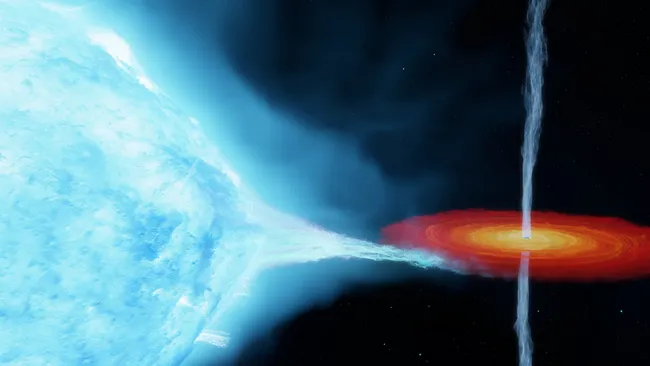This is a periodic change in the intensity of X-ray radiation that can last from a few seconds to a few minutes. Black holes, although not living objects, may have some properties that resemble biological processes. One such phenomenon is the “heartbeat” that occurs when a black hole consumes a large amount of gas. This was revealed in a new study that revealed the mechanism behind this process.
When a black hole is in a binary system with another star, it can draw gas from the star. This gas is compressed and heated to high temperatures, emitting X-rays. It was this process that allowed astronomers to first identify black holes, such as Cygnus X-1, one of the brightest sources of X-ray radiation in the sky.
During the gas consumption process of a black hole, a sudden X-ray emission can occur, caused by the rapid consumption of a large amount of material. This emission can be so strong that it can be detected even from very far away. Astronomers have been studying such flares for years and have discovered that they are sometimes accompanied by a peculiar variability, a regular pulse of activity that resembles the ECG signal of the human heart.
These pulses are called the “heartbeat” of the black hole; they are periodic changes in the intensity of X-ray radiation that can last from a few seconds to a few minutes. This phenomenon has only been detected in two of the hundreds of known black holes and is therefore a very rare and interesting phenomenon.
A team of astronomers from the Chinese Academy of Sciences in Beijing has studied the latest “heartbeat” burst and identified a process that could explain it. They have submitted their work for publication in the Astrophysical Journal.
The flare they studied comes from the black hole IGR J17091-3624, which is 28,000 light-years away from Earth. Using X-ray data from the Neutron Star Internal Composition Explorer (NICER), an X-ray observatory on the ISS, and the Nuclear Spectroscopic Telescope Array (NuSTAR) space-based X-ray telescope, which will be released in 2022, they discovered a similar “heartbeat” phenomenon.
Researchers who studied the event in detail concluded that these pulses are caused by interactions and instabilities within the material surrounding the black hole. When matter falls into a black hole, it forms a thin, rapidly spinning disk that curves downward toward the event horizon. This creates an unstable situation as radiation from the disk competes with the black hole’s gravitational pull.
To cause a “heartbeat,” the disk temporarily breaks apart, losing its coherence and sending a large clump of material toward the black hole. This releases a large amount of radiation, which manifests itself as a “pulse.” The radiation then heats up the gas, which temporarily prevents it from being absorbed. The gas then stabilizes as the process repeats.
The “heartbeat” of a black hole is a complex phenomenon that is not yet fully understood. However, researchers hope to study it in more detail as it provides valuable information about the relationship between black holes and their environment. This could help us better understand the nature of black holes and their role in the evolution of the universe.













